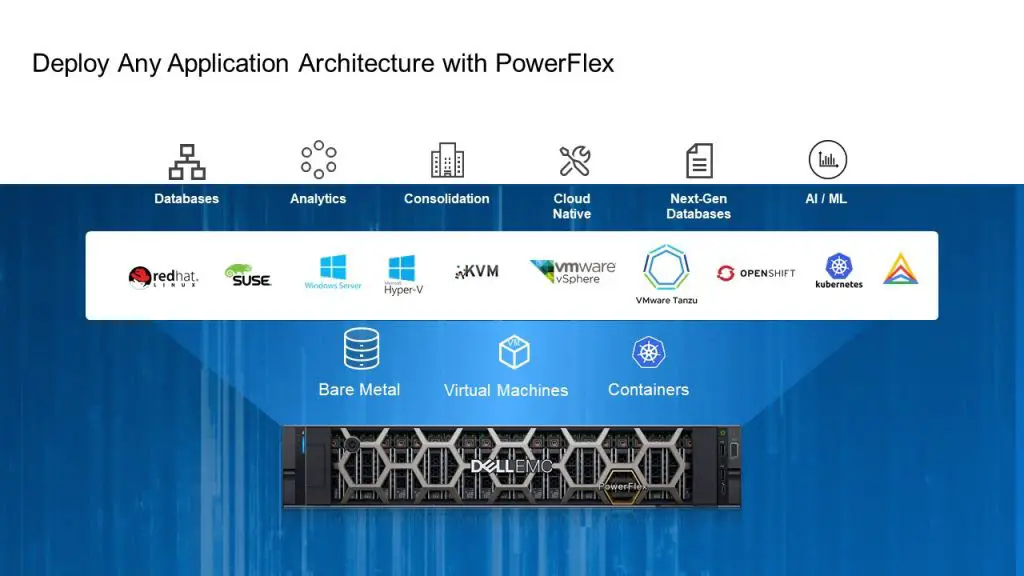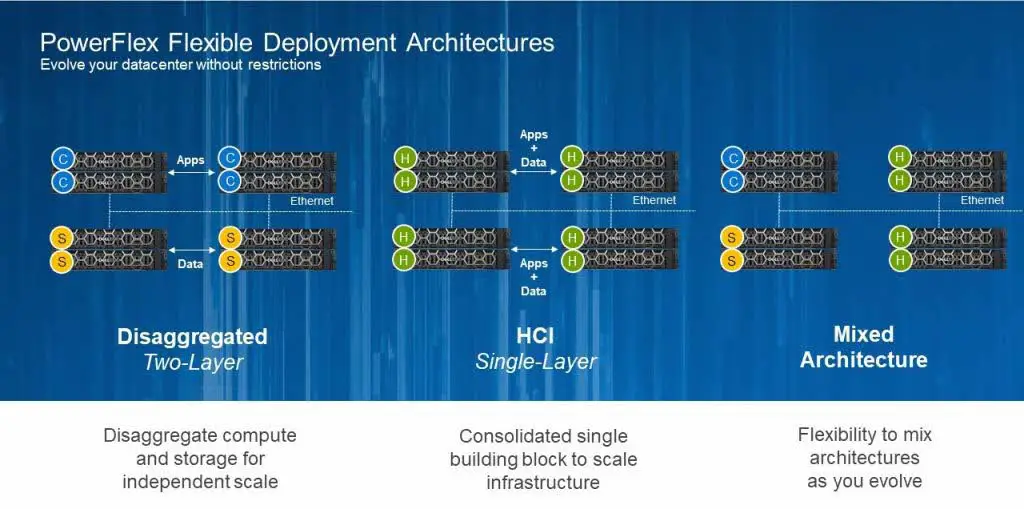Dell EMC PowerFlex: The Ultimate Software-Defined Infrastructure for the Modern Data Center
Block and file storage services are offered by the software-defined infrastructure (SDI) platform Dell EMC PowerFlex. It is made to be extremely scalable, versatile, and resilient, which makes it perfect for a variety of workloads such virtual machines, databases, containers, and big data applications.
PowerFlex is designed with high performance, availability, and scalability in mind. It is built on a distributed architecture that makes use of a range of cutting-edge technologies. Among these technologies are:
- Distributed mesh-mirror architecture: This architecture ensures that data is always protected against hardware failures by maintaining two copies of each data block on different nodes in the cluster.
- Self-healing and self-balancing capabilities: That can automatically detect and repair hardware failures, as well as rebalance data across the cluster to ensure optimal performance.
- Scale-out design: It can be scaled horizontally by adding more nodes to the cluster, allowing organizations to meet their growing storage needs without sacrificing performance.
Benefits of Using Dell EMC PowerFlex
The solution offers a number of benefits to organizations, including:
- Flexibility: That can be used to support a wide range of workloads, including virtual machines, databases, containers, and big data applications.
- Resilience: It is designed to be highly resilient, with features such as distributed mesh-mirror architecture and self-healing capabilities to protect against hardware failures.
- Scalability: That can be scaled horizontally to meet growing storage needs without sacrificing performance.
- Ease of management: It is easy to manage using a variety of tools, including the PowerFlex Manager web interface and the PowerFlex CLI.
PowerFlex Capabilities
It offers a number of features that make it a powerful and versatile SDI platform. Some of the key features of PowerFlex include:
- Distributed mesh-mirror architecture: This architecture ensures that data is always protected against hardware failures by maintaining two copies of each data block on different nodes in the cluster.
- Self-healing and self-balancing capabilities: It can automatically detect and repair hardware failures, as well as rebalance data across the cluster to ensure optimal performance.
- Scale-out design: That can be scaled horizontally by adding more nodes to the cluster, allowing organizations to meet their growing storage needs without sacrificing performance.
- Easy of management: It is easy to manage using a variety of tools, including the PowerFlex Manager web interface and the PowerFlex CLI.
- Support for a wide range of workloads: That can be used to support a wide range of workloads, including virtual machines, databases, containers, and big data applications.
- Integration with other products: That integrates with other products, such as VMware vSphere, PowerProtect, and CloudIQ, to simplify management and provide a comprehensive solution for data center infrastructure.
Use Cases for PowerFlex
It is a versatile SDI platform that can be used to support a wide range of workloads. Some of the most common use cases for PowerFlex include:
- Virtualization: It is a popular choice for virtualized workloads, such as virtual machines and VDI. It offers high performance and scalability, as well as features such as live migration and snapshotting to support virtual machine workloads.
- Databases: It is also a good choice for database workloads, such as Oracle, SQL Server, and MySQL. It offers high performance and availability, as well as features such as asynchronous replication to support database workloads.
- Containers: That can be used to support containerized workloads, such as Kubernetes and Docker. It offers high performance and scalability, as well as features such as persistent volume claims to support containerized workloads.
- Big data: It is also a good choice for big data workloads, such as Hadoop and Spark. It offers high performance and scalability, as well as features such as NFS and HDFS support to support big data workloads.

PowerFlex Deployment Options
PowerFlex can be deployed in a variety of ways, including:
- Two-layer deployment: This is the most common deployment option for that. In a two-layer deployment, the PowerFlex software is installed on a separate set of servers from the servers that run the workloads. This allows for greater flexibility and scalability, as the PowerFlex software can be scaled independently of the workload servers.
- Hyper-converged deployment: In a hyper-converged deployment, the PowerFlex software and the workloads are installed on the same set of servers. This simplifies deployment and management, but it can limit flexibility and scalability.
- Cloud deployment: PowerFlex can also be deployed in the cloud, using the PowerFlex Software for AWS. This allows organizations to leverage the scalability and elasticity of the cloud to support their deployments.

Which deployment option is right for you?
The best deployment option for you will depend on your specific needs and requirements. If you need a flexible and scalable solution, then a two-layer deployment is a good option. If you need a simple and easy-to-manage solution, then a hyper-converged deployment is a good option. And if you need to deploy it in the cloud, then the PowerFlex Software for AWS is a good option.
Here are some additional things to consider when choosing a deployment option for PowerFlex:
- Workload requirements: What types of workloads will you be running on that? Some workloads, such as databases and big data applications, may have specific requirements that need to be considered when choosing a deployment option.
- Budget: Two-layer deployments can be more expensive than hyper-converged deployments, due to the need for additional hardware.
- Management resources: Hyper-converged deployments are easier to manage than two-layer deployments, but they may require additional training and expertise.
If you are unsure which deployment option is right for you, you should consult with a Dell EMC representative. They can help you assess your needs and requirements and recommend the best deployment option for your organization.
PowerFlex Current Models
The following are the current models:
- PowerFlex Appliance:
- R640
- R740xd
- R840
- PowerFlex Software:
- PowerFlex Software for Dell EMC VxFlex Ready Nodes
- PowerFlex Software for Custom Nodes
Conclusion
Dell EMC PowerFlex is a powerful and versatile SDI platform that offers a number of benefits to organizations, including flexibility, resilience, scalability, and ease of management. It can be used to support a wide range of workloads, including virtual machines, databases, containers, and big data applications. It is also integrated with other products to simplify management and provide a comprehensive solution for data center infrastructure.
Further Reading
Dell EMC ECS: The Best Modern Object Storage Platform for Data-Driven Innovation
PowerProtect Appliance (DELL EMC) Types! Choos The Best Option!
I/O Block Size (> 3 MB) Best Practice on EMC AFA/HFA and Linux (Physical and Virtual)
EMC Unity Host Group, Finally Came!
WWN Address in EMC Unity: Best Way to Find
What’s Dell EMC Unity XT Storage?
EMC Unity Secrets (2019) – How to Remove Unwanted Initiators?










